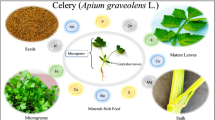Abstract
Celery (Apium graveolens L.), a medicinal crop, occupies a significant position in the human diet possessing several essential macro- and microelements. For proper proximate analysis, an experiment was executed by taking 20 celery genotypes. The genotypes were analyzed for macro- and microminerals which include nitrogen (N), phosphorus (P), potassium (K), calcium (Ca), sodium (Na), sulfur (S), zinc (Zn), iron (Fe), copper (Cu), and manganese (Mn). Results from analysis revealed that the amount of N, P, Ca, Na, and S was higher in microgreens, whereas a higher value for K was found in mature leaves. Zn, Cu, and Mn contents were found to be higher in mature leaves, while no significant difference was observed for Fe content in microgreens and mature leaves. The inclusion of celery microgreens in our daily diet would fulfill a significant portion of our daily mineral requirement. This is the first report on mineral comparison between microgreens and mature leaves of celery. It opens a new avenue for further enhancement of minerals via biofortification of this medicinal wonder crop through systematic breeding efforts. On the basis of mineral analysis, three genotypes, namely PAU2, PAU4, and PAU16, were found superior in terms of mineral composition in microgreens and mature leaves of celery. Principal component and cluster analyses divide the genotypes into two different clusters on the basis of variability in mineral composition.





Similar content being viewed by others
Data Availability
Not applicable.
Data Deposition
Not applicable.
References
Kyriacou MC, Rouphael Y, Di Gioia F, Kyratzis A, Serio F, Renna M, Santamaria P (2016) Micro-scale vegetable production and the rise of microgreens. Trends Food Sci Technol 57:103–115
Xiao Z, Lester GE, Luo Y, Wang Q (2012) Assessment of vitamin and carotenoid concentrations of emerging food products: edible microgreens. J Agric Food Chem 60:7644e7651
Sun J, Xiao Z, Lin LZ, Lester GE, Wang Q, Harnly JM, Chen P (2013) Profiling polyphenols in five Brassica species microgreens by UHPLC-PDA-ESI/HRMSn. J Agric Food Chem 61:10960–10970
Tan L, Nuffer H, Feng J, Kwan SH, Chen H, Tong X, Kong L (2020) Antioxidant properties and sensory evaluation of microgreens from commercial and local farms. Food Sci Hum Wellness 9:45–51
Scherz H, Kirchhoff E (2006) Trace elements in foods: zinc contents of raw foods—a comparison of data originating from different geographical regions of the world. J Food Compost Anal 19:420–433
Maathuis FJ (2009) Physiological functions of mineral macronutrients. Curr Opin Plant Biol 12:250–258
Ambrose DC, Manickavasagan A, Naik R (eds) (2016) Leafy medicinal herbs: botany, chemistry, postharvest technology and uses. CABI
Malhotra SK (2006) Celery. In: Handbook of herbs and spices (pp. 317–336) Woodhead Publishing
Singh M, Nara U, Rani N, Jaswal C (2022) Genetic, genomic and biochemical insights of celery (Apium graveolens L.) in the era of molecular breeding. J Appl Res Med Aromat Plants 100420
Singh M, Choudhary A, Kumar A (2021) Microgreens: a nutritional food. Biotica Res Today 3:612–613
AOAC (1995) Official Methods of Analysis (ed) Association of official analytical chemists, 16th, Washington, DC
Subbiah BV, Asija GL (1956) Rapid procedure for the determination of available nitrogen in soil. Curr Sci 25:259–260
Olsen SR (1954) Estimation of available phosphorus in soils by extraction with sodium bicarbonate (No. 939). US Department of Agriculture
Black CA, Evans DD, White JL (1965) Methods of soil analysis: chemical and microbiological properties (No. 631.410287/B627 V. 2). ASA
Prashanth L, Kattapagari KK, Chitturi RT (2015) A review on role of essential trace elements in health and disease. J NTR Univ Health Sci 4:75
Bhattacharya PT, Misra SR, Hussain M (2016) Nutritional aspects of essential trace elements in oral health and disease: an extensive review. Scientifica 2016:1–12
Biesalski HK, Tinz J (2018) Micronutrients in the life cycle: requirements and sufficient supply. NFS J 11:1–11
Colla G, Kim HJ, Kyriacou MC, Rouphael Y (2018) Nitrate in fruits and vegetables. Sci Hortic 237:221–238
Xiao Z, Codling EE, Luo Y, Nou X, Lester GE, Wang Q (2016) Microgreens of Brassicaceae: mineral composition and content of 30 varieties. J Food Compos Anal 49:87–93
Golubkina NA, Kharchenko VA, Moldovan AI, Koshevarov AA, Zamana S, Nadezhkin S, Caruso G (2020) Yield, growth, quality, biochemical characteristics and elemental composition of plant parts of celery leafy, stalk and root types grown in the northern hemisphere. Plants 9:484
Ghoora MD, Babu DR, Srividya N (2020) Nutrient composition, oxalate content and nutritional ranking of ten culinary microgreens. J Food Compos Anal 91:103495
Pinto E, Almeida AA, Aguiar AA, Ferreira IM (2015) Comparison between the mineral profile and nitrate content of microgreens and mature lettuces. J Food Compos Anal 37:38–43
Zou L, Tan WK, Du Y, Lee HW, Liang X, Lei J, Ong CN (2021) Nutritional metabolites in Brassica rapa subsp. chinensis var. parachinensis (choy sum) at three different growth stages: microgreen, seedling and adult plant. Food Chem 357:129535
Singh M, Nara U, Rani N, Pathak D, Sangha MK, Kaur K (2022) Mineral content variation in leaves, stalks, and seeds of celery (Apium graveolens L.) genotypes. Biol Trace Elem Res 1–9
Qureshi K, Tabassum F, Neelam MA, Akram MZ, Zafar M (2014) Investigation of mineral constituents of Apium graveolens L available in Khyber Pakhtunkhwa-Pakistan. J Pharmacogn Phytochem 3:234–239
Author information
Authors and Affiliations
Contributions
All authors have equal contribution in writing the manuscript.
Corresponding author
Ethics declarations
Ethics Approval
Not applicable.
Conflict of Interest
The authors declare no competing interests.
Additional information
Publisher's Note
Springer Nature remains neutral with regard to jurisdictional claims in published maps and institutional affiliations.
Rights and permissions
Springer Nature or its licensor (e.g. a society or other partner) holds exclusive rights to this article under a publishing agreement with the author(s) or other rightsholder(s); author self-archiving of the accepted manuscript version of this article is solely governed by the terms of such publishing agreement and applicable law.
About this article
Cite this article
Singh, M., Nara, U., Rani, N. et al. Comparison of Mineral Composition in Microgreens and Mature leaves of Celery (Apium graveolens L.). Biol Trace Elem Res 201, 4156–4166 (2023). https://doi.org/10.1007/s12011-022-03483-1
Received:
Accepted:
Published:
Issue Date:
DOI: https://doi.org/10.1007/s12011-022-03483-1




